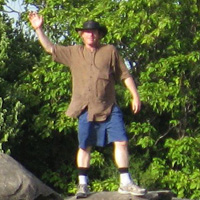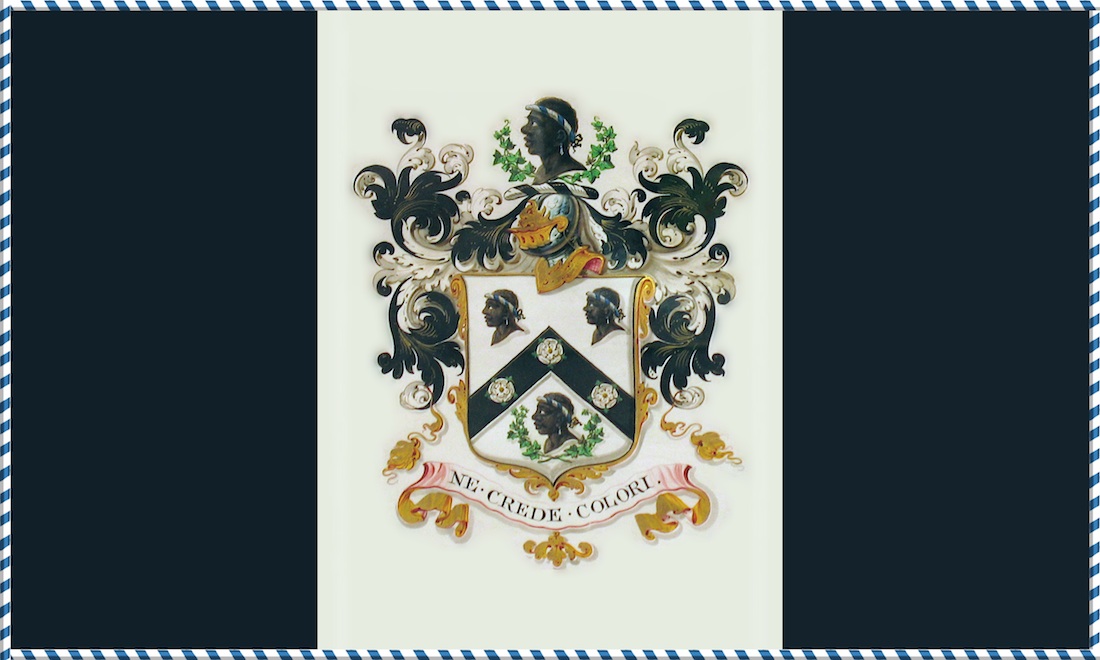


 |
 |
 |
| Eric Hadley-Ives
Sir Eric Joseph Orsay Hadley-Ives, MSW, Ph.D., KOE I use this page as my home page, so here you will find the links I use most often.
|
 |
|
|
|
||
 |
||
 |
||
The image above is the Hadley-Ives family flag. If you click on it, you'll get directed to the Ives family coat of arms and crest. The crest and family coat of arms was granted to my maternal grandfather's grandfather's grandfather, Jeremiah Ives of Colton, (also known as Jeremiah Ives of St Catherine’s Hill). Some sources say he was born in 1776, but he was probably born in 1777, and he lived until 1829. Most sources say he was the son of Jeremiah Ives of Catton Hall (1754-1820), and grandson of Justice Ives (1722-1787, also known as Jeremiah Ives the Elder). However, it seems most likely he was the biological son of Jeremiah Heacock Ives (1754-1778), who was the second cousin of Jeremiah Ives of Catton Hall, and the son of Jeremiah Ives of Town Close (1729-1805), also known as Jeremiah Ives the Younger, of St Clements. Jeremiah Ives the Younger (1729-1805) and Jeremiah Ives the Elder (1722-1787) were (we think) first-cousins. They had a firm known as J & J Ives, which produced textiles in Norwich. Jeremiah Ives of Catton (1754-1820) took the place of his father as business partner with his father’s first cousin, Jeremiah Ives of Town Close (1729-1805). Jeremiah Ives of Town Close (1729-1805) even appointed Jeremiah Ives of Catton (1754-1820) as one of the executors of his will. We do not know what sort of a relationship our ancestor Jeremiah Ives of St Catherines Hill (1777-1829) had with Jeremiah Ives of Catton. I notice that Jeremiah Ives of Catton (1754-1820) was born in the same year as Jeremiah Heacock Ives (1754-1778), and their fathers were cousins and business partners. Perhaps they were very close, and when Jeremiah Heacock Ives died in 1778, Jeremiah Ives of Catton (1754-1820) may have became something like a father figure to Jeremiah Ives (1777-1829). Jeremiah Ives of Town Close (1729-1805, also known as Jeremiah Ives the Younger, of St Clements), who was the grandfather of Jeremiah Ives of Colton / Saint Catherines Hill (1777-1829) was probably not the son of Jeremiah Ives (1692-1741) and Alice Ives (d. 1759). Rather, it seems a near certainty that he was the son of Robert Ives, junior (1687-1759) and Ann Ives neé Halford (1690-1780) (because the will of Robert Ives names him as their son, and then he ended up with their property). It seems to me most likely that Jeremiah Ives (1692-1741) was an uncle, the brother of Robert Ives, junr. (1687-1759). The family arms and crest has been passed down in our family and now hangs on the wall in my mother's home. It is unlikely to be the coat of arms for you if your surname is Ives, although your arms may be very similar. We have some cousins who might have very similar family arms. The basic design of a chevron sable on a field argent with three moors’ heads couped and proper goes back in the Ives family to at least a few generations earlier than Robert Ives, junior (1687-1759), and may actually go back much earlier, so it’s possible that we do have some very distant cousins whose crests and coat-of-arms would be similar to the one we carry. The basic design is mentioned in John Guillim’s Displaye of Heraldrie (1597), and is attributed to the Ives of Bradwell, Norfolk in Burke’s General Armory. The arms of Baron Wenlock (“Argent a chevron beta. three blackamoors’ heads erased proper”), extinct in 1471, were quite similar to ours: the difference being that the heads are erased (jagged where the neck ends) rather than couped (straight line at the base of the neck). The Jeremiah Ives who lived from 1692-1741 used a similar coat of arms as well, and we think he was a younger brother of our ancestor Robert Ives, junior (1687-1759). The use of maures (the heads of dark-complexioned Africans) in European heraldry goes back quite far (to the 11th century). The coat of arms of Sardinia, for example, uses four, one in each of four quadrants. the use of maures has nothing to do with slave trading. In fact, in the case of the Ives family, we know that our ancestors politically supported William Wilberforce. The family motto of “do not trust appearances” is rendered in Latin: Ne Crede Colori, and the use of African heads may be a heraldic pun (men of color on the coat of arms and crest). Here is my full Ives lineage: We gather from Masonic histories that our Norfolk Ives family traced back to John Ives (d. in Borune in 1692) is connected to the radical army chaplain Jeremiah Ives, who supported the Levellers and was in the New Model Army. This 17th century Jeremiah Ives was also a cheesemonger and boxmaker. He flourished betwen 1646-1674, was a General Baptist minister for the congregation in Old Jewry, London, and , and so might have been a brother or first cousin to our ancestor John Ives, or possibly even a father or uncle. The William Ives (1607-1648) who sailed to Boston in 1635 could be connected, perhaps remotely, but we have no evidence for that. Ives is (and has long been) a fairly common surname in Norfolk, and the various Ives families ("Ives" and "Ivo" and "Iveri" and "Iveson") go way back to the 11th century. When you get that far back, given the mathematics of multiple generations of ancestors and intermarriage and so forth, probably every human with English ancestry is a descendant of every person living in England at that time who has desendants living today. My grandfather’s great-grandfather Ferdinand Ives (1807-1876) had a brother named Jeremiah Robert Ives of Bentworth Hall, (1812-1865) and three sisters. One of the sisters was Rachel Anna Barrett-Lennard neé Ives (1805-1847), wife of Rev. Dacre Barrett-Lennard (1801-1839); another was Janette Elizabeth Sergison neé Ives (d. 1846), wife of Rev. William Thomas Sergison. Our closest Ives cousins would be descendents of J. Robert Ives of Bentworth Hall (1812-1865) and his wife, Emma Ives neé Maynard. We know they had nine grandchildren, and these included George Cecil Ives (1867-1950), Violet Emma Frances Laura Gordon-Ives (b. 1884 or 1885), Rosalind Amy Gordon-Ives (b. 1886 or 1887), Cecil Maynard Gordon-Ives (1889-1923), Victor Maynard Gorden-Ives (1890-1914), Violet Maud Cecil Ives (1867-1926), Patrick Robert Cecil Ives (b. 1873), Marion Ives (1874-1950), and Frances Edith Ives (1878-1935). These descendants (great-grandchildren) of Anne and Jeremiah Ives would have been my great-grandfather’s second cousins. It’s clear that some of these cousins, who resided in Bentworth Hall, were using the Ives family arms similar to ours on the left half of their family crest, as shown in a memorial at St. Mary’s Church in Bentworth. Other cousins would include the Sergisons and Barrett-Lennards. My grandfather’s great-grandfather's grandfather Jeremiah Heacock Ives (1754-1778) had a sister named Rachel Elizabeth Drake neé Ives who married William Drake, Esq., of Emersham. They had two daughters who married into the Irby family. These two daughters would have been first cousins to Jeremiah Ives (1777-1829). Rachel Ives Irby neé Drake married (in 1801) George Irby, who in 1825 became the 3rd Baron Boston, and Emily Ives Irby neé Drake, married Frederick Paul Irby (George Irby’s brother). While Rachel and George had a dozen children, including George Ives Irby, the 4th Baron Boston, Emily and Frederick had only one son (Frederick William Irby, of Boyland Hall), and poor Emily died of childbirth complications about a week after their son was born. Our Irby cousins (including the current Lord Boston) do not use the Ives arms in their family arms (the Irby family uses Argent fretty sable on a canton gules a chaplet or, and their crest is a Saracen’s head in profile proper wreathed about the temples argent and sable). As to the Hadley family and their arms, I don't know that the Hadley family from which I trace my descent has ever been given arms. It seems in the United States there are four different major Hadley branches going way back to the 17th Century in New England. There are the descendants of George Hadley of Ipswich (d. 29 Sept. 1686), the descendants of Dennis Hadley (b. circa 1650 and d. 1741 or 1742) of Sudbury, the descendants of Simon Hadley (or Symon Hadley) who came to America in 1712, and the descendants of Benjamin (1684-1776) and Mehitable Hadley. I'm a descendant of Benjamin and Mehitable. Some sources (including some relatives who put up a marker on Benjamin Hadley's grave back around 1910) claim that Benjamin was a descendant of George Hadley of Ipswich, although I think the evidence for this is very doubtful. Other sources claim that Benjamin Hadley was a son of Dennis Hadley, but again, I think there are facts which cast extreme doubt on this connection. With Benjamin Hadley (1684?-1776) there is a connection to Brattleboro, VT, since Hadleys helped settle that corner of Vermont and my ancestor Ebenezer Hadley, Sr. (son of Benjamin and Mehitable) helped charter that town in 1753. By the way, my Hadley male line goes: Benjamin, Ebenezer Sr., Ebenezer Jr., Levi, Simon Peter, William, Arthur (A.B.), Arthur (Don), Chris, and me. Ebenezer Sr. was a veteran of the Revolution and fought at the battle of Saratoga. Levi was a veteran of the War of 1812. William served in Illinois units of the Union army in the Civil War, first at the outbreak of the war and then a second tour of duty late in the war. My Hadley lineage: My earliest American ancestor that I'm aware of is Edward Spaulding, Sr. (1596-1670). He came to Jamestown, Virginia in 1619. His third wife was Rachel Needham Alger Spaulding (circa 1622 - 1670). Edward Spaulding Sr. helped establish the town of Chelmsford, Massachusetts. Edward and Rachel had five children together, and one of these was named Andrew (born 19 November, 1652). Deacon Andrew Spaulding, Sr. (1652-1713), grew up and married Hannah Spaulding neé Jefes (or Jeffts) (1654-1730). Andrew and Hannah had nine children, with the eldest son being Andrew Jr. (born 25 March, 1678). Deacon Andrew Spaulding, Jr. (1678-1753) married Abigail Spaulding neé Warren (1682-1768). They had a dozen children, with one of these being their son, Jacob Spaulding (1704-1776). Jacob married Susanna Spaulding neé Pierce (1705-1787), and Jacob and Susanna were the parents of eleven children in Chelmsford, one of these being Abigail Spaulding (1735-1813), who became Abigail Hadley when she married Ebenezer Hadley, Sr. (1727-1815). So, my great-grandfather’s great-grandfather’s grandmother Abigail was the great-granddaughter of a son of Edward Spaulding, Sr. and Rachel Spaulding, who are 12 generations before me. It seems that from the time of Benjamin and Mehitable down to my great-grandfather A.B. Hadley, my Hadley ancestors were very fecund, with most generations producing over five children who had descendants, and some generations having more than ten children who lived to adulthood. So, my Hadley cousins are quite numerous. As far as I can tell, every Hadley generation from the 1700s through the early 1900s was a prosperous farming family, with some generations involved in local professional occupations and civic society (lawyers, veterans associations, Freemasonry, local politics). My Hadley ancestors appear in historical records around 1700 in Chelmsford, Massachusetts. Later generations lived in places such as Brattleboro, Vermont; Cayuga Lake, New York; Wabash Township, Darke County, Ohio; Hamilton, Ohio; Silver Creek Township, Green County, Ohio; Bond County, Illinois; Herrick, Illinois; Ponca City, Oklahoma; Severy Kansas; Curlew, Washington; Portland, Oregon; Orange County, California; Indianapolis, Indiana; and Orlando, Florida. |
||